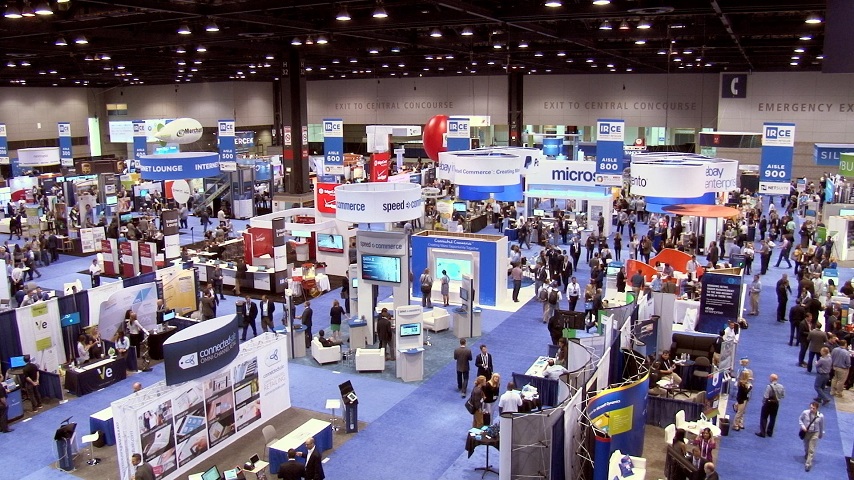Subtotal $0.00
Trade shows are powerful platforms for businesses to showcase their products, connect with industry peers, and generate valuable leads. However, to truly stand out in a competitive environment and maximize return on investment (ROI), event organizers need to deploy effective trade show marketing strategies that not only drive attendance but also enhance engagement and create lasting impressions.
In this blog, we will explore three essential trade show marketing strategies that can help event organizers boost their trade show’s visibility, increase foot traffic, and provide exhibitors and attendees with an experience that delivers value before, during, and after the event.
1. Build a Multi-Channel Promotional Campaign
To effectively promote a trade show, event organizers must adopt a multi-channel marketing strategy. This approach ensures that you’re reaching potential attendees where they are, whether it’s through social media, email marketing, or even paid advertising. A well-coordinated promotional campaign that spans multiple channels helps create awareness and drives registrations from a diverse range of audiences.
Email Marketing
Email marketing remains one of the most direct and effective ways to promote your trade show. Crafting a targeted email marketing campaign allows you to send personalized content to potential attendees and exhibitors, driving registration and encouraging engagement.
Key email marketing tactics:
- Segmented Campaigns: Segment your email lists based on different audience groups such as exhibitors, sponsors, previous attendees, and new prospects. Tailor your messaging to each segment by focusing on what matters most to them. For example, exhibitors might be interested in sponsorship opportunities and booth locations, while attendees might want to know about the keynote speakers and networking events.
- Drip Campaigns: Use an automated drip campaign to build anticipation for the event. Start by sending out save-the-date emails and registration reminders, followed by content that highlights speakers, product showcases, and special sessions. As the event draws near, provide attendees with practical information such as how to navigate the trade show floor and access key sessions.
- Exclusive Offers and Discounts: Encourage early registrations by offering exclusive deals, such as discounted tickets or group rates for teams. Use limited-time promotions and countdown timers in your email campaigns to create a sense of urgency.
- Post-Event Follow-Up: After the trade show concludes, continue engagement through follow-up emails. Send thank-you notes, survey links for feedback, and links to resources like session recordings, whitepapers, or future event announcements. This maintains the connection with attendees and sets the stage for your next event.
Social Media Marketing
Social media platforms provide an excellent opportunity to create buzz around your trade show and engage potential attendees in real time. A strong social media strategy not only drives registrations but also enhances attendee engagement throughout the event.
Key social media strategies:
- Pre-Event Promotions: Use platforms like LinkedIn, Twitter, Facebook, and Instagram to promote your event in the months leading up to the trade show. Share event details, speaker announcements, exhibitor highlights, and behind-the-scenes content. Utilize hashtags specific to your event to make it easier for attendees to follow the conversation and for you to track engagement.
- Paid Social Ads: To extend your reach beyond organic followers, invest in paid social media ads. Platforms like LinkedIn and Facebook allow you to target specific demographics, industries, or interests, ensuring your trade show promotion reaches the right audience. Use retargeting ads to reach people who have visited your event website but haven’t registered yet.
- Influencer Partnerships: Collaborate with industry influencers, thought leaders, or exhibitors to help promote the event. Influencers can create content such as blog posts, videos, or social media posts that promote the trade show and their involvement in it. This type of user-generated content is highly credible and can significantly boost your event’s visibility.
- Social Media Contests and Giveaways: Generate excitement and encourage user engagement by running social media contests or giveaways. For instance, you could offer free tickets to the trade show or exclusive access to specific sessions for those who share your event on their social networks. Contests can help amplify your event’s reach while fostering a sense of anticipation.
Paid Advertising and Search Engine Marketing (SEM)
Paid advertising, including search engine marketing (SEM) and display ads, can effectively drive traffic to your trade show website and increase registration rates. When used strategically, SEM ensures your event appears at the top of search results, giving it greater visibility among relevant audiences.
Key paid advertising tactics:
- Google Ads Campaigns: Create Google Ads campaigns that target relevant keywords such as “industry trade shows,” “business expos,” or specific product categories relevant to your trade show. By bidding on these keywords, your event will appear when potential attendees are actively searching for trade shows or industry events.
- Retargeting Ads: Retargeting campaigns can be particularly effective for increasing registration numbers. Use retargeting ads to reach users who have visited your trade show website or landing page but didn’t complete the registration process. These ads serve as reminders, encouraging them to revisit the site and register.
- Display Ads on Industry Websites: Many industries have niche websites, blogs, or online publications that cater to your target audience. Partner with these platforms to place display ads promoting your trade show. These ads will reach professionals who are already engaging with content relevant to your event, making them more likely to attend.
2. Create Engaging Pre-Event Content and Thought Leadership
Establishing your trade show as a valuable source of industry knowledge and innovation starts with thought leadership and content marketing. By developing high-quality content that provides insights into the trade show’s themes, industries, and exhibitors, you position your event as a must-attend for professionals looking to stay ahead of industry trends.
Thought Leadership Articles and Blog Posts
One of the best ways to promote your trade show is to create blog posts and articles that establish your event as a hub for industry knowledge. Focus on topics that will resonate with your target audience, whether it’s a deep dive into market trends, case studies from key exhibitors, or interviews with industry experts.
Content marketing ideas:
- Industry Trends and Insights: Create content that addresses the latest industry trends that your trade show will focus on. This not only attracts attendees who are interested in these trends but also positions your event as a thought leader in the industry.
- Speaker Spotlights: Interview keynote speakers, panelists, or exhibitors and share these interviews as blog posts, videos, or podcasts. These interviews give your audience a preview of the valuable insights they can expect at your event while also building credibility for the trade show.
- Exhibitor Highlights: Provide sneak peeks into what your exhibitors will showcase at the event. This can help attract attendees who are specifically interested in seeing new products or innovations. Highlighting exhibitor booths or special product launches can create additional excitement and drive attendance.
Webinars and Virtual Pre-Event Content
Offering virtual pre-event content, such as webinars or live-streamed sessions, can build excitement for your trade show and encourage early registrations. These sessions can provide attendees with a preview of what to expect while positioning your event as a source of valuable learning and networking opportunities.
Key pre-event content ideas:
- Virtual Roundtables or Webinars: Host virtual roundtable discussions or webinars with industry leaders and speakers who will be at your trade show. These pre-event webinars can cover pressing industry topics and trends that will also be discussed at the show. Attendees who engage in these virtual sessions are more likely to register for the live event.
- Countdown to the Event: Create a series of countdown-themed content pieces leading up to the event. Each week, focus on a different aspect of the trade show—whether it’s spotlighting speakers, providing tips for making the most of the event, or announcing new exhibitors.
- Video Content and Demos: Use video marketing to share product demos from exhibitors, behind-the-scenes event preparation, or interviews with event organizers. Videos are highly engaging and can be easily shared on social media, your website, and email campaigns.
Content Hubs and Resources
Building a content hub on your trade show’s website can serve as a go-to resource for potential attendees looking for event information, industry trends, and session details. A content hub increases engagement with your website while positioning your event as an authoritative source in the industry.
Key content hub elements:
- Blog Posts and Articles: Regularly publish blog posts that cover topics relevant to your audience. Include how-to guides, industry forecasts, and educational content that aligns with the themes of your trade show.
- Whitepapers and E-books: Offer downloadable whitepapers or e-books that provide in-depth insights into key topics. These gated content pieces can also help you capture leads from those who download them, providing you with valuable data on potential attendees.
- Event-Related Resources: Provide practical resources such as checklists for exhibitors, travel guides for attendees, or an FAQ section that answers common questions about the event.
3. Enhance On-Site Engagement Through Personalization and Technology
Once you’ve successfully marketed your trade show and driven registrations, it’s important to maintain attendee engagement during the event. By leveraging personalization and interactive technology, you can create a memorable trade show experience that encourages participation, builds connections, and ensures that attendees find value throughout the event.
Event Apps for Personalization and Networking
Many trade shows now offer mobile event apps that provide attendees with personalized experiences, allowing them to customize their agenda, connect with exhibitors, and network with other attendees. These apps are an essential tool for enhancing the attendee experience.
Key features of event apps:
- Personalized Schedules: Attendees can use the app to create a personalized schedule based on the sessions they want to attend, exhibitors they want to meet, and networking opportunities. This ensures that they make the most of their time at the event.
- Networking Features: Event apps often include matchmaking features that allow attendees to connect with others based on shared interests or industries. Attendees can schedule one-on-one meetings or participate in group discussions.
- Real-Time Updates: Event organizers can send real-time updates through the app, ensuring that attendees are informed of any changes to the schedule, last-minute announcements, or special sessions.
Interactive Booths and Exhibitor Engagement
Encouraging exhibitors to create interactive and immersive booth experiences is key to keeping attendees engaged on the trade show floor. Exhibitors who provide hands-on experiences, live demos, and interactive displays are more likely to attract foot traffic and leave a lasting impression.
Key interactive booth ideas:
- Product Demos and VR Experiences: Allow attendees to test out products through live demonstrations or virtual reality (VR) experiences. These types of interactive experiences create a memorable and engaging interaction with the brand.
- Gamification: Incorporate gamification into the trade show floor to boost attendee engagement. Offer prizes or incentives for attendees who complete certain tasks, such as visiting a certain number of booths or participating in a scavenger hunt.
- Live Polls and Surveys: Encourage attendees to participate in live polls or surveys at booths, which can also provide exhibitors with valuable insights into attendee preferences and interests.
Post-Event Engagement and Follow-Up
The success of a trade show doesn’t end when the event is over. To maintain momentum and build long-term relationships with attendees, it’s important to implement a strong post-event follow-up strategy.
Key post-event engagement strategies:
- Survey and Feedback Collection: Send out post-event surveys to attendees to gather feedback on their experience. This not only provides valuable insights for future improvements but also shows attendees that their opinions matter.
- Follow-Up Emails: Send personalized follow-up emails to attendees and exhibitors. Include content such as session recordings, key takeaways, and announcements about future events.
- Lead Nurturing Campaigns: For exhibitors, it’s crucial to have a lead-nurturing plan in place. Encourage them to follow up with the leads they collected at the event with personalized offers, product demos, or consultations.
Conclusion
By implementing these three trade show marketing strategies—multi-channel promotional campaigns, engaging pre-event content, and personalized on-site experiences—event organizers can attract the right attendees, enhance engagement, and provide value to both exhibitors and attendees. These strategies ensure that your trade show is not only a memorable experience but also a successful one, delivering strong ROI for all participants involved.







